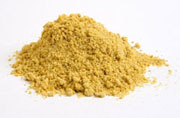| Home A B C D E F G H I J K L M N O P Q R S T U V W X Y Z |
| Home |
Asafoetida (Ferula Foetida): Devil's Dung
|
|
 Devil's
dung sounds like a less than appetizing ingredient to add to your recipe,
but when a pinch is used judiciously, it is sinfully good.
Devil's
dung sounds like a less than appetizing ingredient to add to your recipe,
but when a pinch is used judiciously, it is sinfully good.
Asafoetida is native to Iran, Pakistan and Afghanistan. A perennial plant growing to about six feet high, it is one of several species of ferula, or giant fennel. Asafoetida has finely toothed leaves, clusters many white or yellow flowers in umbels and a hollow stem growing from a fleshy taproot. It is the root that produces the spice. In summer, the stems are cut from four-year-old plants and the root is sliced. A gum is excreted which dries into a resin. This is then crushed into a powder to produce the spice.
The name originates with the Persian word aza, which means "resin", and the Latin word fetida, which means "smelly". Stinking gum (another name for the spice) earns its name. When bought, you will usually find it triple wrapped for the smell can be quite offensive. However, sauté it lightly in oil and it develops a pleasant onion or garlic like aroma. A mere pinch is all you need in any recipe.
Medicinally, asafoetida is used in Middle Eastern and Indian herbal medicine for simple digestive problems such as gas, bloating, indigestion and constipation. It has been used for respiratory problems such as bronchitis, asthma and whooping cough. Like garlic, asafoetida's volatile oil contains components such as disulphides that leave the body via the respiratory system and aid in the coughing up of congested mucus. Asafoetida has also been used as a sedative. It also thins the blood and lowers blood pressure. Although safe for adults, asafoetida may be harmful to young babies.
One beneficial use for asafoetida's unpleasant smell is that of a natural pesticide. Two of the sulfur compounds isolated from asafoetida are similar to the insect repelling qualities of marigolds and nasturtiums. Asafoetida's fetor will also repel deer and rabbits.
In magic and mythology, asafoetida is used to gain insight and to banish all negative energy, evil spirits and demons. It is used to invoke male gods, especially those of a phallic nature. One myth claims that asafoetida developed from the semen of a god of fertility when it soaked into the earth. Asafoetida is sometimes worn around the neck as an amulet to ward off colds and fevers.
Although very reasonably priced today, in ancient times it was a precious and expensive condiment. The Roman epicure Apicius recommended adding an uncrushed piece of asafoetida resin to a jar of pine nuts. When the asafoetida flavor was required, a few of the pine nuts were crumbled and added to the dish.
Culinary uses of asafoetida include the flavoring of pickles and sauces (it is one of the ingredients in Worcestershire sauce) and it is used extensively in the Middle East to flavor spicy vegetable dishes. Some people simply rub their broiling rack with the spice prior to cooking meat.
Here are a couple of recipes that can be prepared individually or together as a vegetarian meal or as accompaniments to a meat dish.
Nutty Rice with Mushrooms
One cup of long grain brown rice, cooked
8 - 10 mushrooms, sliced
A large fistful of chopped fresh parsley
A small fistful of pine nuts
Juice of half a lemon
Two tbsp. butter
Pinch of ground asafoetida
Salt and freshly ground black pepper to taste.
Sauté the mushrooms in the butter, pouring the lemon juice over them after they are nicely browned. Lightly roast the pine nuts for a few minutes in a small, unoiled pan, which should be constantly shaken. Mix all the ingredients into the cooked rice and reheat if necessary. Serves four.
Peppery Tomatoes with Mushrooms
About 1 lb. mushrooms, sliced
5 medium-sized fresh tomatoes, cut up
2 fresh jalapeno peppers, diced
2 tbsp. olive oil
Quarter tsp. turmeric
Pinch of ground asafoetida
Half tsp. ground cumin
2 tsp. salt
Quarter tsp. brown sugar.
Heat the oil over a medium heat in a deep-sided, lidded frying pan. Add
the spices in the order listed allowing a few seconds between additions.
Stir in the mushrooms and lightly brown them before adding the tomatoes,
salt and sugar. Cook over medium to high heat uncovered until the liquid
from the tomatoes has been reduced to a stew-like consistency. Cover and
reduce heat to simmer. Serve after about 10 minutes of simmering or, even
better, prepare ahead of time, allow to cool and then reheat. A few hours
of dormancy really develops the flavors. This recipe will serve 2-4 as
a side dish. Increase ingredients proportionately if serving more or if
preparing as main dish.
About The Author:
Bruce Burnett is an award-winning writer, a chartered herbalist and author
of HerbWise: Growing Cooking Wellbeing. Read more published articles
by Bruce Burnett on his websites: http://www.bruceburnett.ca
and http://www.herbalcuisine.com
|
Glossary References Links Contact
|